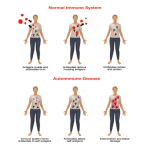
Dr. Newman examines a patient.
W. Winn Chatham, MD, director of rheumatology clinical services at the University of Alabama, Birmingham, discussed tools available in Cerner that may not get used to their fullest potential. Cerner has been used in the clinic at UAB for about eight years, he said.
Infobuttons: These links in the EMR for labs, medications or other details log you directly into UpToDate, letting the user search for related topics.
External prescription history: This gives a side-by-side comparison of a patient’s Cerner prescription list and their prescription history in Surescripts, a national database of pharmacy information.
“This is very helpful when we’re trying to figure out what your patients are actually taking,” Dr. Chatham said. A caveat is that Surescripts doesn’t include prescriptions paid for with cash, only insurance-covered ones.
PDMP (Prescription Drug Monitoring Program) integration: This is a look into the state’s registry letting you know about a patient’s prescriptions for controlled substances, even if they’re paid for with cash.
“You can always see what else your patient’s taking that they don’t tell you about,” Dr. Chatham said.
Results FYI: This feature lets physicians receive alerts about such things as selected lab results or patient encounters when they’re not the ordering physician. This includes patient visits to the emergency department or visits to another specialist. This has to be configured, though, by clicking on the message folder and choosing manage configurations in the inbox menu and going to the FYI results subscriptions tab.
Limit menu options: “If you decrease the menu options on the left column, it will decrease your load time,” Dr. Chatham said. Retiring old alerts will also improve the system’s performance.
Copying last note forward: The last note can be copied forward to use as a template for the next encounter, Dr. Chatham said. In a lupus clinic, for instance, a note routinely includes ACR criteria, the latest SLEDAI scores and damage index.
“Having that copied forward is vital,” he said. “You just have to be careful that you edit the note appropriately.”
Thomas R. Collins is a freelance writer living in South Florida.

